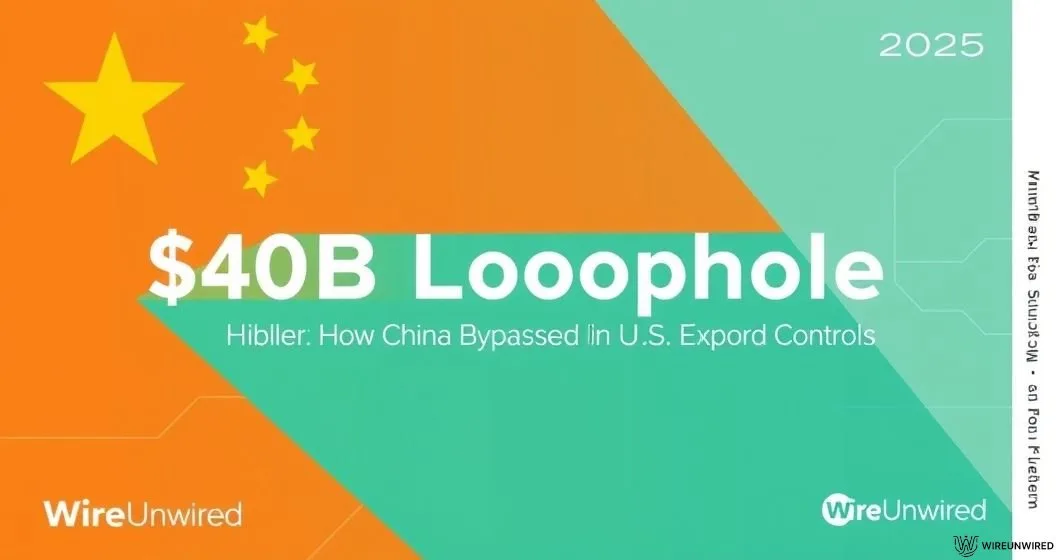Key Insights
- Chinese firms purchased nearly $40 billion in advanced chipmaking equipment in 2023 despite U.S.-led export restrictions, according to a bipartisan House investigation
- Sales from major suppliers to China rose 66% from 2022, with China accounting for 39% of combined revenues from Applied Materials, Lam Research, KLA, ASML, and Tokyo Electron
- Regulatory gaps between the U.S., Japan, and Netherlands allowed non-U.S. suppliers to continue selling advanced semiconductor manufacturing equipment to Chinese companies
A comprehensive investigation by the U.S. House Select Committee on China has exposed a massive $40 billion loophole that allowed Chinese semiconductor firms to circumvent American export controls throughout 2023. The bipartisan report reveals how regulatory inconsistencies between allied nations created opportunities for China to acquire advanced chipmaking equipment despite escalating technological restrictions.
The Scale of the Semiconductor Export Control Breach
The investigation found that Chinese companies successfully purchased nearly $40 billion worth of advanced semiconductor manufacturing equipment in 2023, representing a staggering 66% increase from 2022 levels. This surge occurred even as the United States implemented its most comprehensive semiconductor export controls targeting China’s technological advancement capabilities.
Five major suppliers—Applied Materials, Lam Research, KLA, ASML, and Tokyo Electron—saw their combined sales to China reach unprecedented levels, with Chinese purchases accounting for nearly 39% of their total revenues. This concentration highlights how China maintained access to critical semiconductor manufacturing tools despite U.S. efforts to limit such transfers.
Exploiting Allied Coordination Gaps
The House committee’s findings point to regulatory gaps and timing inconsistencies between the United States, Japan, and the Netherlands as the primary enablers of this massive equipment acquisition. While the U.S. implemented strict controls in October 2022, allied nations delayed their own restrictions, creating windows of opportunity for Chinese firms.
According to the investigation, Dutch and Japanese enforcement didn’t take effect until July and September 2023 respectively, despite announcements in March 2023. This delay allowed Chinese companies to engage in massive stockpiling efforts, with import values increasing from $2.9 billion to $5 billion during comparable periods.
Strategic Implications for Semiconductor Manufacturing
The committee warns that these equipment purchases have significantly enhanced China’s semiconductor manufacturing capabilities, potentially undermining Western technological advantages in artificial intelligence and military applications. The acquired equipment enables Chinese firms to produce more advanced chips domestically, reducing their dependence on foreign suppliers.
Industry experts note that modern semiconductor manufacturing equipment can remain productive for decades, meaning the 2023 purchases will continue benefiting Chinese chipmakers long after current restrictions take full effect. This creates lasting competitive advantages that extend far beyond the immediate policy implementation period.
Current Export Control Evolution
In response to the findings of the House Select Committee on China:
- The Trump administration has enacted updated export controls intended to address the regulatory loopholes exposed in the 2023 breach.
- These measures include stricter enforcement of the Foreign Direct Product Rule (FDPR), a significant expansion of the Entity List to include more Chinese semiconductor-related firms, and enhanced coordination with U.S. allies to close timing and regulatory gaps.
- Specific focus has been placed on curbing access to advanced manufacturing equipment and high bandwidth memory (HBM) chips, with a particular emphasis on preventing indirect acquisitions through shell companies or third-country proxies.
Industry and Policy Response
The revelations have sparked intense debate among policymakers and industry leaders about the effectiveness of current export control strategies. Tokyo Electron’s U.S. unit president acknowledged declining sales to China in 2024 due to tighter rules but emphasized the need for more coordinated global action.
“The appetite and capacity of Chinese customers and companies that want to sell to them to find legal loopholes is infinite, and they don’t take days off in that journey, whereas what our government has demonstrated is the ability to do one update per year.”
Regional media across Asia have highlighted the profound implications for global technology competition and national security, with particular attention to how these developments affect semiconductor supply chains throughout the Asia-Pacific region.
Future Coordination Challenges
The House committee’s findings underscore the critical importance of synchronized implementation among allied nations when implementing technology export controls. The report calls for broader, more coordinated restrictions that prevent Chinese firms from exploiting regulatory timing differences and jurisdiction gaps.
Moving forward, the effectiveness of semiconductor export controls will largely depend on whether the United States can achieve genuine coordination with key allies, particularly Japan and the Netherlands, which host critical semiconductor equipment manufacturers. The December 2024 updates represent progress toward this goal, but significant implementation challenges remain as Chinese firms continue developing new circumvention strategies.
Discover more from WireUnwired Research
Subscribe to get the latest posts sent to your email.




